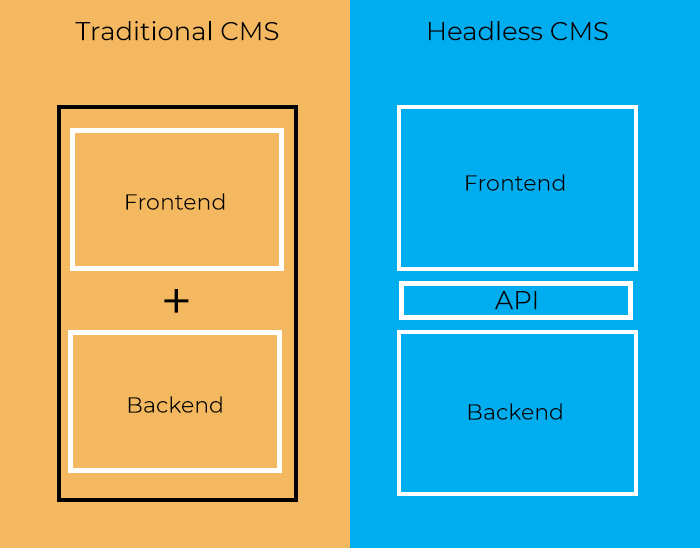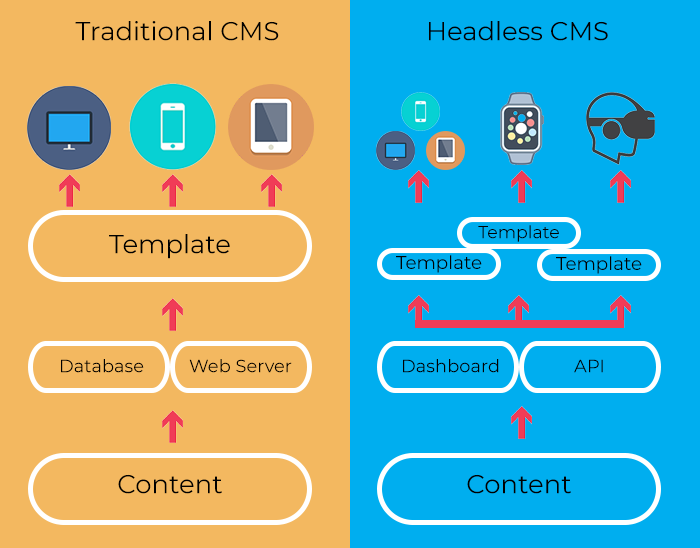A CMS – Content Management System for a website helps the users create, modify, and manage the content on a website, mostly using the simple drag and drop option. The Content Management Systems are designed to normalize the no-code trend as the users don't need to do coding to create, edit or delete content from a website. Traditional CMSs gave us the content, the editing dashboard, themes and templates, and areas to put custom codes in one place. This setup has been successful since the era of website building. But, with new devices and changes in the content display options, we now need more because traditional CMSs were not designed to cope with today's technology.
A popular example of CMS is WordPress. You can create, edit, or delete the posts and pages for your website without doing any of the coding. You work at the backend, and your work is showcased at the front-end. The drag and drop options in themes and templates let you easily control the website's front-end design. The basics of a CMS are easily manageable, but you need a developer/designer experienced in that specific CMS to scale up the design and content display.
What is Headless CMS?

Consider the front-end of a website as 'head' and the website's backend as 'body.' Now, a headless CMS is something that is not connected with the front-end directly. In traditional CMS setup, your content and design are managed in one place for both 'backend' and 'front-end.' In the case of a headless CMS, you manage the content of the website at the backend and use an API (Application Programming Interface), mostly RESTful API (XML, JSON) to publish it on the front-end. This way, you can display content on any device because it is being fetched through the API.
The content developed at the backend in a headless CMS is delivered at multiple fronts such as wearable, OTT, Web, e-Commerce, React, Mobile Apps, Ember, and more. This is the reason why headless CMS became popular. There's no front-end restriction or a defined front-end environment, unlike traditional CMS.
You manage backend- fixed API – any UI.
When to Use a Headless CMS?

A headless CMS is not always beneficial. It depends on your specific requirements. What do you want to achieve that tells which type of CMS would be best for you.
If you want platform independence, i.e., you want your content supplied to multiple platforms and multiple devices, then a headless CMS is a good choice. A Headless CMS also helps when you want cross-platform support, freedom in choosing the type of technology, and simplicity in coding.
A headless CMS allows you to quickly deliver the development work, and it will perform better than the traditional CMS projects because most of the content is loaded directly from the visitors' browser. Its decoupled nature makes it more secure. Your front-end is separated from the backend reducing the risks of DDoS and other attacks.
Headless in eCommerce
In a headless setting, the front-end is separated from the eCommerce platform. Shopify offers headless solutions through Shopify Plus. The functionality is supported through Storefront API.
"Storefront API gives you full creative control to add Shopify buying experiences anywhere your customers are, including websites, apps, and video games. Storefront API is useful when Shopify merchants have custom requirements not met by existing channels like an online store or POS."
With Storefront API, you can use Shopify outside the typical channels. Headless Shopify websites use JavaScript Buy SDK which helps you to convert any website into an eCommerce website by rendering the data on the client-side or server. It retrieves products and the collection of products, creates a fully functional shopping cart, allows the users to add products to the cart and increase quantity, and generates checkout URL for a single product or the entire cart.
The JS Buy SDK is a lightweight library that allows you to build eCommerce into any website. It's based on Shopify's Storefront API and provides the ability to retrieve products and collections from your shop, add products to cart, and checkout.
Why Choose Headless with Shopify eCommerce?
As Shopify promotes it – headless CMS is anywhere commerce. You can use any device to check out the products, directly increasing sales. Headless CMS combined with Shopify Plus commerce engine allows you to create custom storefronts across devices. Customer engagement skyrockets as you cover different screen types such as Kiosks, wearables, billboards, smart devices with screens, among others. And, you don't have to settle for an average-looking store. The customization options help you design an attractive and beautiful storefront. Create shopping experiences as unique as your brand and customers.
Cons Surrounding Headless CMS
- There are inevitable downsides of working on a headless CMS;
- You need to maintain the backend and front-end separately. A few find it easy, while some find it difficult as the general perception is about managing everything in one place.
- Integration options are available, but there are more complex than they are in traditional CMS.
- With the freedom of multiple devices or platforms, there comes the issue of device version control.
- Cost is comparatively high in developing and maintaining a headless CMS.



